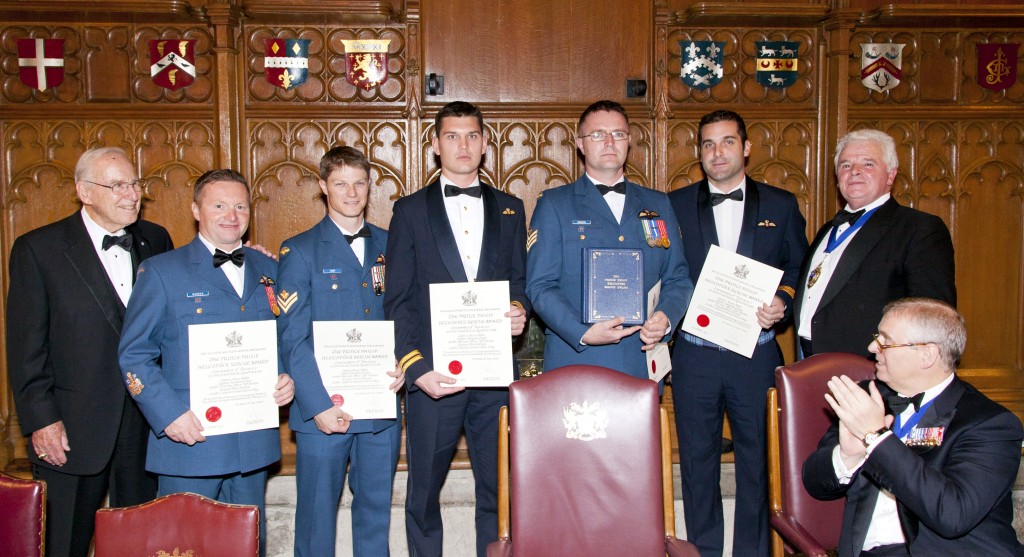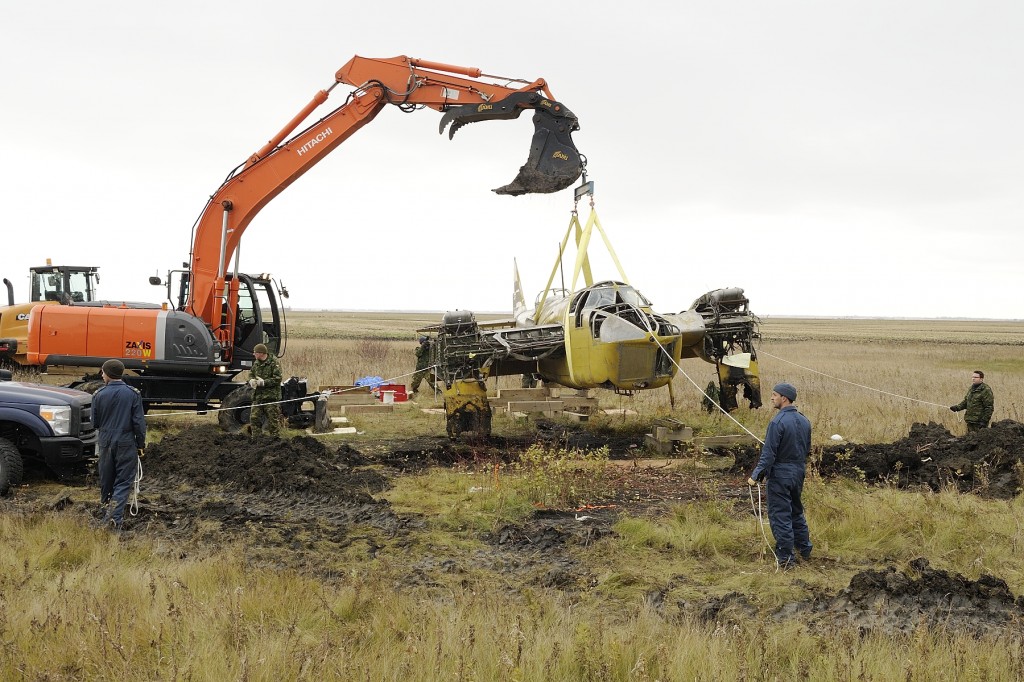
Caption: 24013 Jonathan Groten (Class of 2008 – fourth from the left) was part of the team from 103 Rescue Squadron receiving the Prince Phillip Helicopter Rescue Award recently in London, England for a daring rescue performed earlier this year along the Nfld coast. Also of note in the picture is Jim Lovell (“Houston, we have a problem – Apollo 13 commander) is on far left; HRH Prince Andrew is seated, on right.
The Prince Philip Helicopter Rescue Award, 103 Sqn SAR RCAF
‘Rescue 912’ crewed by Capt Aaron Noble (Aircraft Captain), 24013 Capt Jonathan Groten – Class of 2008, Sgt Bradley Hiscock, MWO Jeffrey Warden and MCpl Mark Vokey was tasked on the night of 9 February 2013, to the aid of three hunters who had become stranded in their 16-foot aluminum boat after their route to land was engulfed with large amounts of ice. The weather had become a full-on winter blizzard with expected accumulation of 40 cm of snow and gale force winds across the island of Newfoundland gusting up to 75 kph. The hunters’ chances for survival were rapidly diminishing as they had been exposed to these conditions for almost 20 hours.
R912 departed Gander airport in extreme instrument flight rules (IFR) conditions with an approximately 200-foot cloudbase, encountering icing conditions immediately after departure. Due to high winds, it took 30 minutes to make the 40NM flight. Upon arriving on scene, the crew found the narrow inlet of Indian Bay still immersed in a blizzard. The flight routing was extended several miles past the hunters to open water in order to conduct an overwater transition down (OWTD) to arrive in a 100’ hover above the water.
Just above minimum limits, SAR tech team lead, MWO Jeffrey Warden spotted the water from the left spotter window. Due to the rugged topography, the three hunters were now approximately eight miles away, and R912 was forced to navigate among many islands and into the narrow inlet to reach them. The crew slowly crept their way toward the hunters at five knots through the smattering of islands, into Indian Bay. This proved to be extremely challenging with up to 80 kph winds on the tail of the helicopter, and severe turbulence off the surrounding 300-foot hills. Wind and turbulence conditions had become so severe that Captain Noble considered calling off the rescue twice.
With approximately two miles remaining, Captain Noble turned the helicopter 180 degrees – placing the nose into the storm – to provide a more stable flying platform, and the crew then navigated him the final two miles among the islands flying backwards. Tremendous crew co-ordination was essential to the success of this manoeuvre. Captain Groten on the map, flight engineer Sergeant Bradley Hiscock on the right in the rescue door, Master Warrant Officer Warden in the left spotter window, and the second SAR tech, Master Corporal Mark Vokey, at the tail, the crew successfully guided Captain Noble backwards toward the hunters’ last known position, at which point Master Warrant Officer Warden spotted the hunters’ lights and red flares.
R912 was now at the estimated minimum fuel level to complete the mission. With minimal references over the ice and open water, Master Corporal Vokey was hoisted into the blizzard and down to the distressed seamen, fighting through the storm’s intensity, fierce rotorwash and static electric shock from the aircraft. The three hypothermic hunters were transferred to Gandar where Rescue 912 broke out of IFR conditions only just above minimum allowances and landed without further incident, having demonstrated remarkable professionalism and achievement that led to the saving of three lives.
___________________________
Bristol Bolinbroke – MK IV Donated to 17 Wing –
Trainer slowly sank into prairie sod for 60 years
By Sgt Bill McLeod – 17 Wing Photojournalist
Briefly and at a very low altitude, a Bristol Bolingbroke Mark IV aircraft took to the sky for the first time in over 60 years near MacDonald, Manitoba, as it was lifted from it’s resting place in the prairie sod on October 23, 2013.
The Bolingbroke was donated to 17 Wing by David Morris, Ian Morris, Stephen Morris and Royal Canadian Air Force Captain 20940 Sean Morris – Class of 1997. The Bollingbroke was originally purchased in 1946 by George Morris, grandfather of the men, for $150 as surplus from British Commonwealth Air Training Plan RCAF Station Macdonald. The aircraft was towed from the rear wheel by a grain truck to the family farm just a few miles away.
“I think the intention was to use the bits and pieces of it for farming,” says Captain Sean Morris, a helicopter pilot who was just posted from 3 Canadian Forces Flying Training School in Portage la Prairie, just a few miles from the family farm, to the Joint Rescue Coordination Centre in Esquimault, British Columbia.
“From what I’ve been told, all they really took off was the tail wheel, used on a wheel barrow, and the gas tanks for use on a sprayer,” he added.
“My dad remembers pumping up the hydraulics and spinning the turret around,” says Captain Morris. “In reality, it is probably his love of the plane and aviation that got me into it. So I guess I am a second generation inspired pilot.”
From October 21 until October 30, the 17 Wing Recovery and Salvage Team led by Warrant Officer Steve Sagriff and assisted by members of 17 Wing Transport, Electrical, Mechanical Engineers carefully dug the aircraft out of the ground and gently disassembled the aircraft for trucking back to 17 Wing.
“We had to dig down about four feet with the excavator,” said Warrant Officer Sagriff.
“The guys on the Recovery and Salvage team are a great bunch of guys,” said Sagriff. “They didn’t even stop for lunch on Tuesday (October 22) until 3:00 p.m. They just kept saying, ‘We’re so close, so close’,” he said.
“The TEME (17 Wing Transport, Electrical, Mechanical Engineers) guys were great too,” he added. “They were slinging lumber around with us and everything.”
On Tuesday, October 29, the last and biggest piece of the Bristol Bolingbroke Mark IV, the fuselage, was lifted off the flatbed in Winnipeg under the watchful eye of 17 Wing Heritage Officer Lieutenant Amber Dodds.
“It’s going to be a long process to restore it,” Lieutenant Dodds said. “Our Ghost Squadron is a group of 5 volunteers who come in every Monday so it would be impossible to provide a guess on when the aircraft would be completed,” she said.
RCAF Station Macdonald is one of the waypoints for the students doing pilot training with 3 Canadian Forces Flying Training School at Portage la Prairie so the aircraft is familiar to everyone at the school.
“If you ask anyone who has been flying at the school in Portage for any length of time, they will know the plane,” says Captain Sean Morris. “It’s an easy thing to see from the air.


